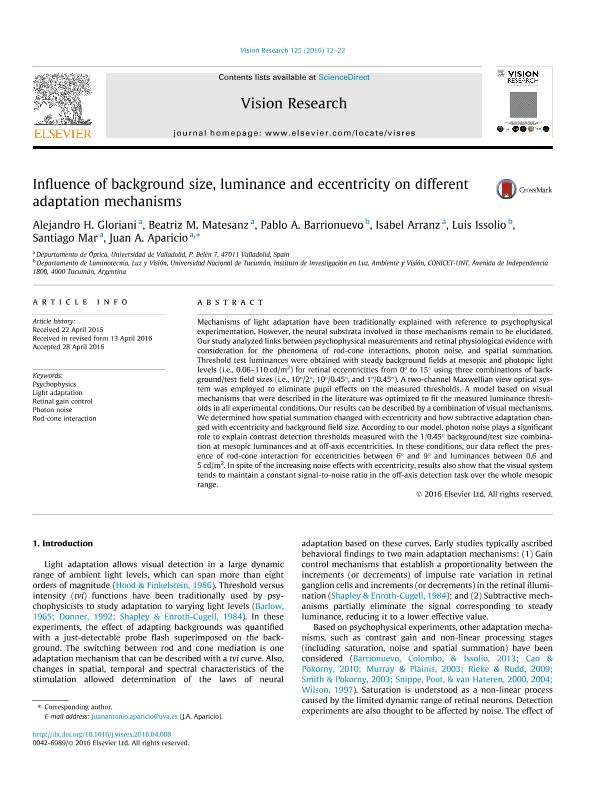Mostrar el registro sencillo del ítem
dc.contributor.author
Gloriani, Alejandro H.
dc.contributor.author
Matesanz, Beatriz M.
dc.contributor.author
Barrionuevo, Pablo Alejandro

dc.contributor.author
Arranz, Isabel
dc.contributor.author
Issolio, Luis Alberto

dc.contributor.author
Mar, Santiago
dc.contributor.author
Aparicio, Juan A.
dc.date.available
2018-09-21T23:45:54Z
dc.date.issued
2016-08
dc.identifier.citation
Gloriani, Alejandro H.; Matesanz, Beatriz M.; Barrionuevo, Pablo Alejandro; Arranz, Isabel; Issolio, Luis Alberto; et al.; Influence of background size, luminance and eccentricity on different adaptation mechanisms; Pergamon-Elsevier Science Ltd; Vision Research; 125; 8-2016; 12-22
dc.identifier.issn
0042-6989
dc.identifier.uri
http://hdl.handle.net/11336/60700
dc.description.abstract
Mechanisms of light adaptation have been traditionally explained with reference to psychophysical experimentation. However, the neural substrata involved in those mechanisms remain to be elucidated. Our study analyzed links between psychophysical measurements and retinal physiological evidence with consideration for the phenomena of rod-cone interactions, photon noise, and spatial summation. Threshold test luminances were obtained with steady background fields at mesopic and photopic light levels (i.e., 0.06-110 cd/m2) for retinal eccentricities from 0° to 15° using three combinations of background/test field sizes (i.e., 10°/2°, 10°/0.45°, and 1°/0.45°). A two-channel Maxwellian view optical system was employed to eliminate pupil effects on the measured thresholds. A model based on visual mechanisms that were described in the literature was optimized to fit the measured luminance thresholds in all experimental conditions. Our results can be described by a combination of visual mechanisms. We determined how spatial summation changed with eccentricity and how subtractive adaptation changed with eccentricity and background field size. According to our model, photon noise plays a significant role to explain contrast detection thresholds measured with the 1/0.45° background/test size combination at mesopic luminances and at off-axis eccentricities. In these conditions, our data reflect the presence of rod-cone interaction for eccentricities between 6° and 9° and luminances between 0.6 and 5 cd/m2. In spite of the increasing noise effects with eccentricity, results also show that the visual system tends to maintain a constant signal-to-noise ratio in the off-axis detection task over the whole mesopic range.
dc.format
application/pdf
dc.language.iso
eng
dc.publisher
Pergamon-Elsevier Science Ltd

dc.rights
info:eu-repo/semantics/openAccess
dc.rights.uri
https://creativecommons.org/licenses/by-nc-nd/2.5/ar/
dc.subject
Light Adaptation
dc.subject
Photon Noise
dc.subject
Psychophysics
dc.subject
Retinal Gain Control
dc.subject
Rod-Cone Interaction
dc.subject.classification
Neurociencias

dc.subject.classification
Medicina Básica

dc.subject.classification
CIENCIAS MÉDICAS Y DE LA SALUD

dc.title
Influence of background size, luminance and eccentricity on different adaptation mechanisms
dc.type
info:eu-repo/semantics/article
dc.type
info:ar-repo/semantics/artículo
dc.type
info:eu-repo/semantics/publishedVersion
dc.date.updated
2018-09-18T16:33:03Z
dc.journal.volume
125
dc.journal.pagination
12-22
dc.journal.pais
Estados Unidos

dc.journal.ciudad
Nueva York
dc.description.fil
Fil: Gloriani, Alejandro H.. Universidad de Valladolid; España
dc.description.fil
Fil: Matesanz, Beatriz M.. Universidad de Valladolid; España
dc.description.fil
Fil: Barrionuevo, Pablo Alejandro. Consejo Nacional de Investigaciones Científicas y Técnicas. Centro Científico Tecnológico Conicet - Tucumán. Instituto de Investigación en Luz, Ambiente y Visión. Universidad Nacional de Tucumán. Facultad de Ciencias Exactas y Tecnología. Instituto de Investigación en Luz, Ambiente y Visión; Argentina
dc.description.fil
Fil: Arranz, Isabel. Universidad de Valladolid; España
dc.description.fil
Fil: Issolio, Luis Alberto. Consejo Nacional de Investigaciones Científicas y Técnicas. Centro Científico Tecnológico Conicet - Tucumán. Instituto de Investigación en Luz, Ambiente y Visión. Universidad Nacional de Tucumán. Facultad de Ciencias Exactas y Tecnología. Instituto de Investigación en Luz, Ambiente y Visión; Argentina
dc.description.fil
Fil: Mar, Santiago. Universidad de Valladolid; España
dc.description.fil
Fil: Aparicio, Juan A.. Universidad de Valladolid; España
dc.journal.title
Vision Research

dc.relation.alternativeid
info:eu-repo/semantics/altIdentifier/url/https://www.sciencedirect.com/science/article/pii/S004269891630027X
dc.relation.alternativeid
info:eu-repo/semantics/altIdentifier/doi/http://dx.doi.org/10.1016/j.visres.2016.04.008
dc.relation.alternativeid
info:eu-repo/semantics/altIdentifier/url/https://www.ncbi.nlm.nih.gov/pmc/articles/PMC4955780/
Archivos asociados
